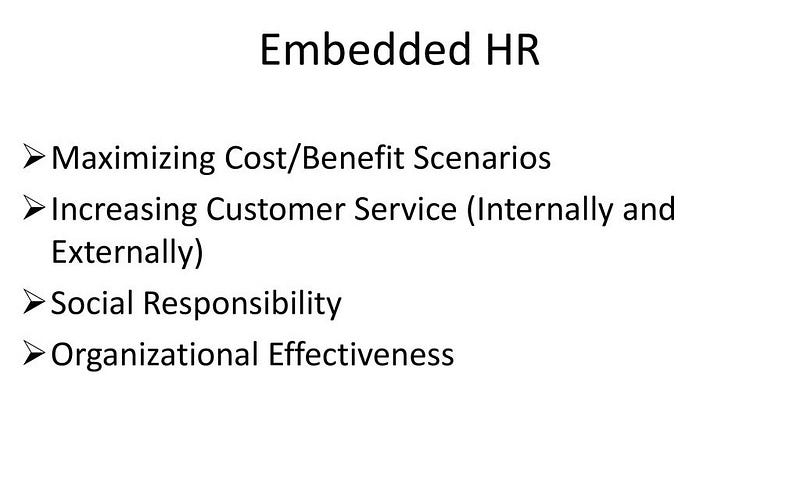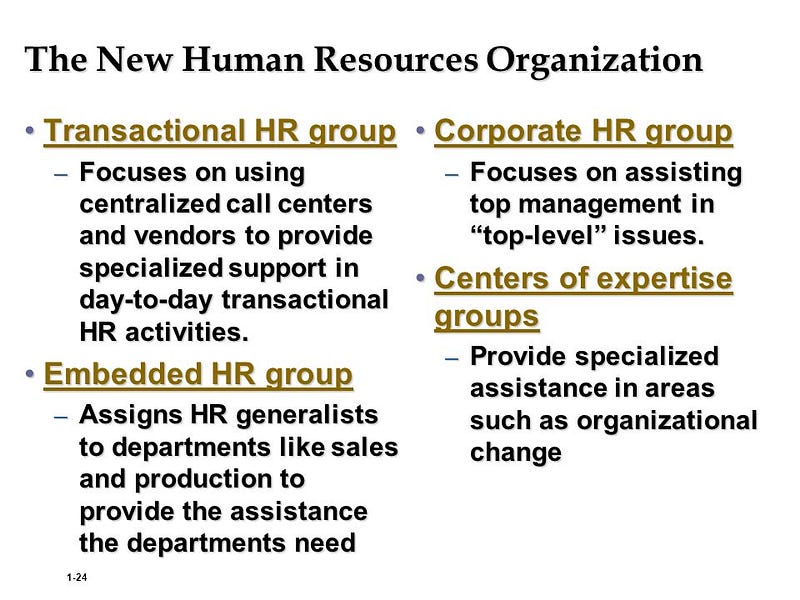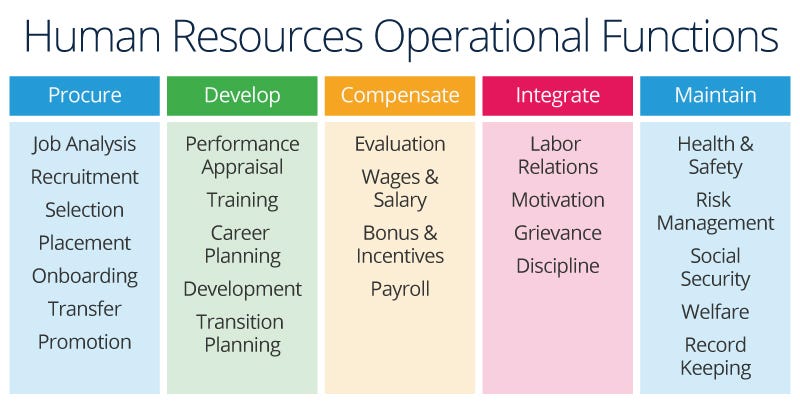In the first two chapters of our HR transformation series we answer questions to why (do HR transformation) and what (outcomes) of HR Transformation. In this chapter, we address the “how”. How do we digitally transform the HR functions & processes completely and make it better?
This phase essentially has three components, each of which is a way of defining what we mean by HR:
- The HR function or department may need to be redesigned.
- HR practices may be transformed to be more effective or more fully aligned, integrated, and innovative.
- HR professionals may be upgraded to possess the competencies required to do their work.
Table of Contents
- Transformation of the HR Strategy
1.1. Who You Are
1.2. What You Deliver
1.3. Why You Do It - Transformation of the HR Organization
- HR Channel 1: Service Centers
3.1. Technology-Enabled Employee Self-Service Centers
3.2. Customization and Building from Scratch or Buying off the Shelf
3.3. Gathering Data or Generating Information
3.4. Collecting Data or Maintaining Privacy
3.5. Archiving or Updating Information
3.6. Outsourced Service Centers
3.7. Cost Savings
3.8. Standardization and Simplicity
3.9. Increased Speed and Quality of Service - HR Channel 2: Corporate HR (HR Oversight)
- HR Channel 3: Embedded HR (Strategic Business Partnering)
- HR Channel 4: Centers of Expertise (HR Expertise)
- HR Channel 5: Operational Execution
7.1. Selecting the Right Individuals
7.2. Developing the Skills Needed to Be Successful
7.3. Managing Priorities and Workloads
7.4. Maintaining Business Focus - Conclusion
1. Transformation of the HR Strategy
Why have the HR Strategy in the first place? An HR strategy gives focus and direction to the HR department. There are many versions and dimensions of strategy statements in general and HR in particular. In transforming the strategy of a specific HR department, the statement of strategy should answer three questions, in this order:
- Who are you? (vision)
- What do you deliver? (mission or value proposition)
- Why do you do it? (the results we want to achieve)
1.1. Who Are You?
Who you are, represents an identity or image of your organization, which is what an HR strategy should offer to outsides as well as inside of the function. This identity shapes both stakeholder and internal HR professional expectations focus on the future rather than the past, align with business requirements, and offers a stretch goal.
The identity will be through the roles and actions performed by HR professionals including facilitators, coaches, architects, partners, planners, contributors, thought leaders, creators, players, or executors.
The identity should be tested and confirmed with line managers who use your services, with employees who are affected by policies you create, with customers and investors whose relationship with your firm is shaped by your policies, and within the HR function by your HR professionals.
1.2. What Do You Deliver?
What you deliver is the set of outcomes. These outcomes should include the capabilities an organization needs to succeed, which can also be characterized as the intangibles an organization promises its investors.
For example, an HR department might ensure productivity, build individual talent, increase speed, establish a shared mindset, improve accountability, or foster innovation. Defining HR deliverables comes from doing organizational audits.
1.3. Why You Do, What you do?
This question links to the business context and specific business results tied to key stakeholders. This part of the HR strategy builds on the “so that” statement and can include increased revenue, customer share, customer loyalty, or total market return. These “so that” statements should imply measures that allow you to monitor the progress human resources makes and the impact it has on the business.
2. Transformation of the HR Organization

Transforming an HR department requires building an HR organization that reflects both the business organization and the HR strategy. The three overriding organizational design principles are: First, make the HR organization follow the logic and structure of the business organization. Second, make the HR organization follow the flow of any professional service organization. Third, differentiate between transactional and transformational HR work.
The HR organization adds value when its logic and structure reflect the logic and structure of the company that it serves. A company whose portfolio strategy is based on a holding company configuration consists of multiple business units who are independent of each other.
The rule of thumb to be followed is that the HR strategy and structure should mirror those of the company. The second organizational design principle for HR is that of any professional service firm. A law firm, advertising agency, accounting firm, or consulting firm earns recognition, respect, and client loyalty by making knowledge productive. A third design principle for successful HR transformation is differentiating and managing both strategic and transactional work effectively.
The work about business context and key capabilities creates the context for knowing what works in your business is or should be strategic. Once this is done, the process involves evaluating each and every HR output and determining how the output contributes to the business. It also requires making sure that administrative or transactional work is done efficiently.
Building on these three design principles, the evolving HR organization
can have five distinct and at times overlapping sets of responsibilities. These five responsibilities represent the channels or ways of doing HR work which we’ll look at below. Awareness of all five channels is helpful in identifying both current and future HR outputs to ensure all outputs are included in your analysis.
Note: At times, some try to transform the HR department by focusing on
just one channel. For example, putting in a new HR information system can increase the efficiency of doing HR administrative work, but this is not a complete HR transformation unless the other roles are also redesigned.
Let’s look at these channels one by one.
3. HR Channel 1: Service Centers

Service centers emerged in the late 1990s as HR leaders (and leaders of other functional organizations such as IT, finance, and purchasing as well) realized that many administrative tasks are more efficiently performed in a centralized, standardized way. The maturation of information technology also contributed to the growth of service centers and their transfer to lower-cost parts of the world.
Service centers require a standardization of HR processes, thus reducing redundancy and duplication, and they can also be accessible 24 hours a day, 7 days a week, from inside or outside the company because of technology. Transformation of service centers comes primarily through technology-enabled employee self-service, outsourcing, or both. Transformation of service centers comes primarily through technology-enabled employee self-service, outsourcing, or both.
3.1. Technology-Enabled Employee Self-Service Centers
Properly designed technology enables employees to manage much of their own HR administrative work. The popular term emerging for this trend is self-service. Employees can also take care of many routine transactions whenever they wish because automated systems don’t keep office hours.
3.2. Customization and Building from Scratch or Buying off the Shelf
Companies often regard themselves as unique, but in today’s world, it is best to avoid designing and implementing a unique HR data portal and service or to significantly customize one.
One company spent thousands of hours creating its unique HRIT system only to wind up with something that simply wasn’t as good as what it could have bought off the shelf for a fraction the cost.
3.3. Gathering Data or Generating Information

Source: www.peerconnect.org.au
One clear benefit of self-service is the ability to collect data on trends and needs. For example, knowing how many younger and older employees use e-learning can help in planning and employee communication. But data does not improve decision making unless it is used. Data that is warehoused in files and never fully deployed might as well not exist.
3.4. Collecting Data or Maintaining Privacy
Concerns over privacy continue to be a major challenge. The more data accumulates, the more the firm knows about the employee, and the harder it is to keep the data secure. Each employee needs to find ways to manage this balance, technology can become increasingly intrusive and inhibit the work-life balance that helps give employees purpose and meaning at work and at home.
3.5. Archiving or Updating Information
Too often in building an HR information system, the focus is on the creation of the system, not its maintenance. Just as new buildings need 15–20 percent of the total cost budgeted for annual maintenance, HRIT investments should factor in an additional 15–20 percent of the original costs as a budget for annual operations. This means updating information on the system as well as periodic updates of the system itself.
3.6. Outsourced Service Centers
Outsourcing draws on the premise that knowledge and process capacity are assets that can be tapped without ownership. HR expertise can be shared across boundaries by alliances in which two or more firms together create a common service or by outright purchase from vendors who specialize in offering it. In transforming HR through outsourcing, the vendors take advantage of economies of knowledge and scale.
3.7. Cost Savings
Savings have been in the 20–25% range should be a substantial amount for large companies, which spend an average of $1,600 per employee per year on administration.
3.8. Standardization and Simplicity
Outsourcing requires consistent HR transactions. Many large firms have grown through mergers and acquisitions, accumulating diverse HR systems. Simply contracting out this workforce a level of consistency that might take years to accomplish internally.
3.9. Increased Speed and Quality of Service
Outsourcing vendors generally rely on technology and have the economies of scale to stay up to date with new developments that continuously improve their services. Employees often perceive service as actually improving with effective outsourcing.
4. HR Channel 2: Corporate HR (HR Oversight)

The corporate HR role can be redesigned to address six important responsibilities, which are discussed as follows:
To create a consistent firm-wide culture and identity.
The work of corporate HR professionals creates a consistent cultural identity for the corporation. No matter how diversified the business strategy, unless the company is truly a holding company that operates as an investment portfolio, a variety of important external stakeholders form relationships with the entire firm.
They shape the programs that implement the CEO’s agenda.
Corporate HR professionals shape the programs that implement the CEO’s agenda. Corporate HR professionals are expected to convert this agenda into a plan for investment and action and to build organizational readiness to deliver this agenda by defining capabilities, designing HR practices, and facilitating action plans to deliver corporation-wide HR work.
They design processes to make sure that HR work aligns to business goals.
Corporate HR is responsible for making sure that HR work done within the corporation is aligned to business goals. Corporate HR can create and mandate a clear process for linking business strategy and HR that can be adapted to each unit. Corporate HR referees debates on sameness versus the difference in HR practices across operations and specific businesses.
They arbitrate disputes between centers of expertise and embedded HR.
Corporate HR is responsible for making sure that HR work done within the corporation is aligned to business goals. Corporate HR can create and mandate a clear process for linking business strategy and HR that can be adapted to each unit. Corporate HR referees debates on sameness versus the difference in HR practices across operations and specific businesses.
They take primary responsibility for HR services of corporate-level employees.
Corporate HR professionals arbitrate disputes between centers of expertise and embedded HR (HR professionals within the businesses or operations). Centers of expertise naturally lean toward consistency, while embedded HR professionals prefer flexibility and choice in response to the unique needs of their stakeholders.
They ensure HR professional development.
Corporate HR professionals take primary responsibility for nurturing corporate-level employees — a role both like and unlike that of HR elsewhere in the firm. Like all employees, corporate employees should perform their transaction HR work through service centers or technology.
Finally, corporate HR is responsible for ensuring ongoing HR professional development. As the corporate HR channel is redesigned, these six responsibilities should be taken into account so that corporate HR professionals have clear expectations.
5. HR Channel 3: Embedded HR (Strategic Business Partnering)
In shared service organizations, some HR professionals work in organizational units defined by geographic location, product line, or functions such as R&D or engineering. These HR professionals, whom we call “embedded HR,” go by many titles such as relationship managers, HR business partners, or HR generalists.

In redesigning embedded HR professionals’ roles, a number of their responsibilities should be clarified:
They engage in and support business strategy assessment and review. Embedded HR professionals engage in and support business strategy, offering insights and helping leaders to identify where their organization can and should invest resources to win new business ventures or increase existing investments’ performance.
They represent employee interests and are attentive to the implications of change. They help to frame the process of business strategy development, are proactive in providing insights into business issues, have a personal vision of the future of the business, and facilitate effective strategy development discussions within the management team.
They define requirements to reach business goals and identify where problems may exist. Throughout the strategy formulation and implementation process, embedded HR professionals audit the organization to define what is required to reach the goals and where problems may exist.

They select and implement the HR practices that are most appropriate for the delivery of the business strategy.
Based on organizational audit information, embedded HR professionals select and implement the HR practices most appropriate for delivering the business strategy. In doing so, they are expected to bring their unique knowledge of the business and its people in selecting practices that add value, integrating them to deliver capabilities, and sequencing them to ensure implementation.
Finally, They measure and track performance to see whether the HR investments made by the business deliver the intended value.
6. HR Channel 4: Centers of Expertise (HR Expertise)
Center-of-expertise HR professionals play a number of important roles that should be clarified in an HR transformation:
- They create service menus aligned with the capabilities driving business strategy.
- They diagnose needs and recommend services most appropriate to the
situation. - They collaborate with embedded HR professionals in selecting and implementing the right services.
- They create new menu offerings if the current offerings are insufficient.
- They manage the menu.
- They shepherd the learning community within the organization.
As an internal design and process consultants, HR professionals in centers of expertise create menus of HR best practices. The menus layout choices of what has been or could be done to deliver high-quality human resources. The center of expertise should already have a menu of choices available to individual organizations.

The center is expected to collaborate with the embedded professional in making the selection and in supporting the implementation.
An HR redesign should ensure that the accountabilities or centers are understood and accepted and that HR professionals in these roles have the abilities to meet these expectations. Those in the center have to stay current with HR processes and frameworks that can add value to the business, while not falling victim to the oft-repeated mistake of creating solutions looking for problems.
7. HR Channel 5: Operational Execution

A large number of HR departments have attempted to operationalize the model we’ve described, but many of them find that some work continues to fall through the cracks. While embedded HR professionals are asked and expected to be strategic and do organizational diagnosis, they often find themselves overwhelmed by operational HR work that conflicts with their the main purpose and renders them unable to make high-value-added strategic contributions.
Service centers typically do not perform these operational tasks since they require personal attention; centers of expertise do not perform them since they usually require deep and unique knowledge of the business and strong internal business relationships; line managers do not perform them since they lack technical expertise.
Organizations thinking of creating an operational HR capability face some challenges that need to be addressed if the effort is to be successful. Our discussions with HR leaders suggest the following factors are particularly important:
7.1. Selecting the Right Individuals
Operational HR roles require a particular set of competencies. These roles are best for people who are execution- and implementation-oriented rather than focused on strategic relationships (embedded HR) or new knowledge creation (centers of expertise).
7.2. Developing the Skills Needed to Be Successful
Project and implementation management skills are crucial for operational HR professionals, but so are team skills. They must quickly understand what is expected. They must bring together the embedded, business, and center of expertise HR professionals in clarifying goals, roles, specific actions, and measures.
7.3. Managing Priorities and Workloads
HRs don’t have infinite resources, and it is all too easy for HR to use its scarce operational HR resources on lower-priority work that other HR professionals do not want to do. This is a mistake as it trivializes both the operational HR work and the people who do the operational HR work.
7.4. Maintaining Business Focus
In all considerations, operational HR must maintain an unrelenting focus on business logic that is consistent with the logic of the corporate business portfolio. Regardless of whether the corporation is a single business unit, diversified, or a holding company, HR should maintain its focus on making the corporate business logic successful.
8. Conclusion
In this chapter, we lay out a two-step approach to redesigning an HR department. First, it requires a clear statement of the HR strategy. This statement comes from answering three questions. (Who are we? What do we deliver? And why do we do it?) This statement becomes the basis for further transformation work.
Second, redesigning an HR department means understanding what work is strategic and what work is transactional. This sets a baseline for clarifying five channels through which HR work is delivered. It then allows you to organize the channels in a way that delivers the most value to the business. When the responsibilities of each of these five channels are defined and acted on, the department redesign has moved forward.
Reference
https://epdf.pub/hr-transformation-building-human-resources-from-the-outside-in.html
DAVE ULRICH, JUSTIN ALLEN, WAYNE BROCKBANK, JON YOUNGER MARK NYMAN
#HRTransformation Series
- Introduction to HR Transformation — Chapter 1
- Why do HR Transformation? – Chapter 2
- What are the Outcomes of HR Transformation? – Chapter 3
- Redesigning the HR Department – Chapter 4
- How to do HR Transformation – Chapter 5
- Upgrade HR Professionals – Chapter 6
- Sharing Accountability for HR Transformation – Chapter 7
- Making HR Transformation a Success – Chapter 8






6 Comments
PingbackShare Accountability for the Transformation - Chapter 7 | Digidesk Blog
PingbackUpgrade HR Professionals - Chapter 6 | Digidesk Blog
PingbackMaking It Happen - Chapter 8 | Digidesk Blog
PingbackIntroduction to HR Transformation—Chapter 1 | Digidesk Blog
PingbackWhy do the Transformation? | Digidesk Blog
PingbackOutcomes of HR Transformation | Digidesk Blog